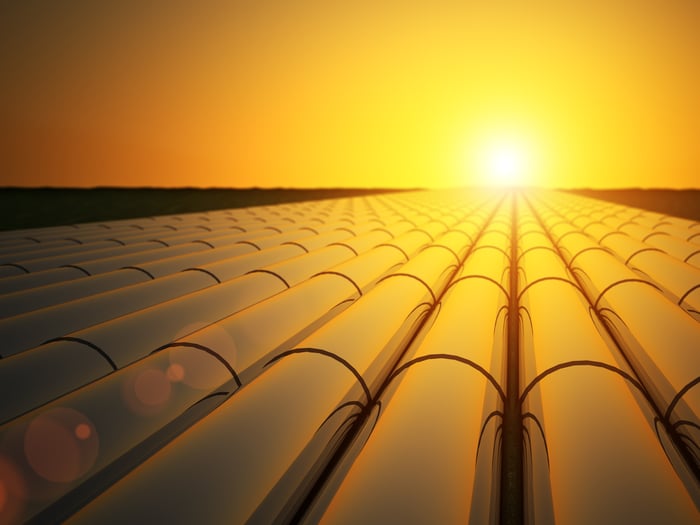If 2020 taught us anything from an investing perspective, it's that companies that are built to last are better able to withstand the unexpected negative surprises the world throws at them. Hopefully, we're closer to the end of the COVID-19 pandemic that caused last year's turmoil than the beginning of it. Still, history suggests that there will be another market shock in the future, which makes it important to continue looking for companies that are built to last for your long-term investments.
Some key characteristics of a company built to last include a solid balance sheet, a moat protecting its operations against competition, and business lines that meet key needs of its customers. With that in mind, these three stocks look like they're built to last and thus might be worth buying to hold for the next 10 years.

Image source: Getty Images.
North America's largest energy infrastructure company
Even with the rapid rise of renewable energy, the U.S. Energy Information Administration projects oil and natural gas demand to remain strong for decades to come. All that energy has to be transported from where it's produced to where it's consumed, which makes Enbridge (ENB 1.71%) worthy of consideration. North America's largest energy infrastructure company, Enbridge is a leader in moving energy around the continent.
As long as that demand for energy remains strong, there will be a need to transport it, and pipelines like the ones Enbridge operates tend to be among the lowest cost ways to do that. On top of the low cost advantage, new pipeline capacity tends to be politically difficult to build, which makes existing infrastructure that much more valuable.
From a balance sheet perspective, Enbridge sports a debt to equity ratio around 1.0, which is about the corporate equivalent of owning a house worth $200,000 with a $100,000 mortgage attached. When combined with cash flows that depend more on the amount of energy that flows through its pipes than the price of that energy, that's a reasonable debt load for a business with a strong potential future.
A rock-solid insurance titan

Image source: Getty Images.
Prudential Financial (PRU 1.26%) is so focused on assuring that it's built to last that it uses an actual rock formation -- the Rock of Gibraltar -- as its corporate symbol. That use is an attempt to showcase how "rock solid" its balance sheet is in order to attract customers. Fortunately for potential investors, it backs that boast up with cold, hard cash and bonds. As of the end of December 2020, it had around $13.7 billion in cash and well over $400 billion in bonds backing up its insurance operations.
On top of that, with over $68 billion in net equity on that balance sheet, a lot can go wrong above and beyond what the company is expecting, and it still can wind up OK. Insurance is the business of pricing risk -- of figuring out what can go wrong and what it will cost to make amends. While insurance companies are pretty good at that, they're not perfect. A solid balance sheet is what gives them flexibility for those times when they get it wrong.
From an investor's perspective Prudential Financial is trading at around half its book value, which provides a good reason to believe its shares aren't overpriced. Prudential also offers its shareholders a yield around 5.7%, from a dividend it recently increased. That dividend provides nice income for investors, and the increase indicates that Prudential Financial expects it will generate sufficient cash to cover that payment. That bodes well for its prospects over time.
A company poised to do well when the "free money" ends

Image source: Getty Images.
The Federal Reserve's balance sheet has ballooned as it has bought up corporate bonds during the COVID-19 pandemic. That has led to some of the lowest interest rates on record for businesses and even in some cases consumers, fueled by that very deep pocketed buyer. The problem with all that cheap money is that it tends to drive inflation. In addition, when money flows freely, it also increases the odds that loans are made that probably wouldn't have been made under tighter money conditions.
When lending conditions tighten, risker loans often start to go bad. That can happen either because the borrower got into trouble and can't make the payments or because the lender stopped being willing to extend new credit, thus forcing default when the old loans mature. Either way, when loans go bad, companies like PRA Group (PRAA -2.35%) step in to start collecting on those debts.
Although PRA Group does have a debt to equity ratio around 2.1, the largest debts on its balance sheet appear to be credit facilities that it has been extending without much issue over the past few years. Fitting for a company in the debt buying business, its receivables (the amount it is owed) is actually higher than its own total debt load. That gives good reason to believe its own lenders will be willing to continue extending credit or that it can find other lenders who would do so in a pinch.
From an investor's perspective, PRA Group trades at around 11.5 times its forward earnings estimates. and those earnings are expected to grow at a healthy clip over the next five or so years. With that combination, prospective investors are well positioned to see decent returns if the future plays out anywhere close to those projections. Add that to a business that could do well as lending tightens, and PRA Group looks worthy of consideration for a spot in a longer-term focused portfolio.
Companies worth considering for the long haul
Although PRA Group, Prudential Financial, and Enbridge operate in vastly different business lines, they all look like reasonable businesses to consider investing in for the long haul. If you're trying to figure out what to invest in given the crazy times we find ourselves in today, each of them is worthy of your consideration. They're all well positioned in their industries, serve key needs for their customers, and have decent balance sheets of their own. With that combination, they may very well be able to last for the long haul.





